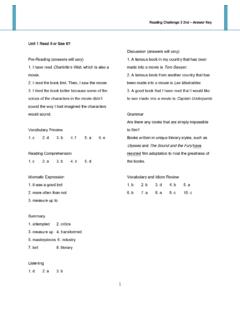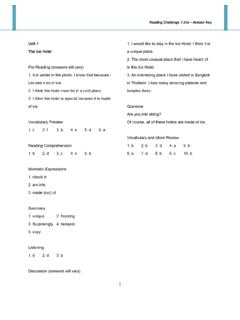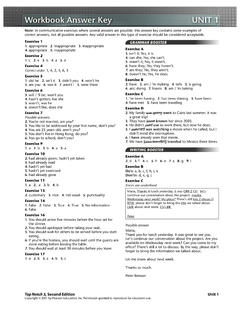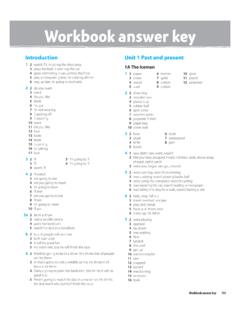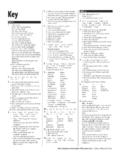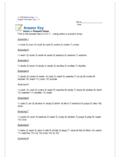Transcription of Introduction to Matter ANSWER KEY - Lab35
1 Pearson Education, Inc., publishing as Pearson Prentice Hall. All rights reserved. ANSWER KEY Introduction to Matter Introduction to Matter Chapter ProjectWorksheet 1 1. The object to be massed is placed on one side of the balance. Objects with known masses are placed on the other side of the arm until the balance arm is level. 2. Sample ANSWER : Balance arm, center pivot point, containers to hold objects at each end of the balance arm, indicator scale to show when the balance arm is level 3. Sample ANSWER : Volume; I can measure the mass of the substance in the same container that I will use to measure volume. 4. Sample ANSWER : Each substance will have its own container. I will use identical containers for each substance.
2 5. Sample ANSWER : I will measure an exact volume of water, such as 20 ml, in a graduated cylinder, pour it into my container, and draw a line at the water level. I will test the accuracy by filling the container with water to the line and measuring the volume of the water in the grad-uated cylinder. If it doesn t measure 20 ml, then I will readjust the line on my container. Worksheet 2 1. Most students will have the same volume for each material, but the mass for each will dif-fer depending on the density of the material. 2. Density = [Mass (g) / Volume (cm 3 )] 3. In most cases, students will measure mass in grams and volume in milliliters. 1 mL = 1 cm 3 4. Check student calculations for accuracy.
3 Describing Matter Guided Reading and Study Use Target Reading Skillsmatter Matter is anything that has mass and takes up space. chemistry Chemistry is the study of the proper-ties of Matter and how Matter changes. substance A substance is a single kind of Matter that is pure and has a specific set of properties. physical property A physical property can be observed without changing a substance into another substance. chemical property A chemical property describes the ability of a substance to change into a different substance. element An element is a pure substance that cannot be broken down into any other sub-stance by chemical or physical means. atom An atom is the basic particle of an element.
4 Chemical bond A chemical bond is a force of attraction between two atoms. molecule A molecule is a particle formed when two or more atoms are held together by chemi-cal bonds. compound A compound is a pure substance made of two or more elements chemically com-bined in a set ratio. chemical formula A chemical formula shows the elements in the compound and the ratio of atoms. mixture A mixture is two or more substances that are together in the same place but are not chemically combined. heterogeneous mixture The different parts in a heterogeneous mixture can be seen. homogeneous mixture The substances in a homogeneous mixture are so evenly mixed that the different parts cannot be seen.
5 Solution A solution is an example of a homoge-nous mixture. 1. chemistry 2. true 3. physical 4. a. chemical b. physical c. physical d. chem-ical e. physical f. chemical 5. element 6. false 7. chemical bond 8. two 9. A pure substance made of two or more ele-ments chemically combined in a set ratio 10. 1 carbon atom to 2 oxygen atoms 11. CO 12. false 13. mixture 14. a. Each substance in a mixture keeps its individual properties. b. The parts of a mixture are not combined in a set ratio. 15. a, d 16. true 17. Each substance in a mixture keeps its own properties. The parts of a mixture are not com-bined in a set ratio. ANSWER KEY Introduction to Matter Pearson Education, Inc.
6 , publishing as Pearson Prentice Hall. All rights reserved. Describing Matter Review and Reinforce 1. physical 2. chemical 3. physical 4. physical 5. chemical 6. physical 7. A compound is made of two or more ele-ments that are chemically combined. Com-pounds have properties that are different from those of the uncombined elements. 8. Each substance in a mixture keeps its indi-vidual properties. The parts of a mixture are not combined in a set ratio. 9. c 10. g 11. e 12. a 13. j 14. d 15. i 16. b 17. h 18. f Describing Matter Enrich 1. The wood chips floated on the surface of the water and were removed from the mixture using either the strainer or the slotted spoon. 2. Once the wood chips were separated from the mixture, the sand could be removed by care-fully pouring the mixture through the strainer lined with a coffee filter.
7 3. The sugar can be separated from the water by allowing the water to evaporate. 4. Yes. The water and sugar formed a solution because the two parts were so evenly mixed that you could not see them. Measuring Matter Guided Reading and Study Use Target Reading Skills Sample questions and answers : How are weight and mass different? (Weight is a measure of the force of gravity on an object. Mass is a measure of the amount of Matter in an object. What is volume? (Volume is the amount of space that Matter occupies.) How is density determined? (Density is deter-mined by dividing the mass of a sample of mat-ter by its volume.) 1. weight 2. false 3. Mass is the measurement of the amount of Matter in an object.)
8 4. Unlike weight, mass does not change with location, even when the force of gravity changes. 5. the International System of Units 6. kilogram 7. volume 8. liter (L), milliliter (mL), cubic centimeter (cm 3 ) 9. volume = length width height 10. Sand and feathers have different densities, and therefore, different volumes. 11. Density = [Mass/Volume] 12. Since wood floats, its density is less than the density of water, 1 g/cm 3 . Since iron sinks, its density is greater than the density of water. 13. false Pearson Education, Inc., publishing as Pearson Prentice Hall. All rights reserved. ANSWER KEY Introduction to Matter Introduction to Matter Measuring Matter Review and Reinforce 1.
9 Volume = 5 cm 3 cm 10 cm = 150 cm 3 2. density = 180 g 150 cm 3 = g/cm 3 3. The mass of the solid would be the same on the moon, but the weight would change. Weight is based on the force of gravity. Weight changes from planet to planet, because the force of grav-ity changes. Mass stays the same no Matter where it is measured. 4. The solid has a density greater than that of water ( g/cm 3 ). 5. No. Density is mass divided by volume. The same dimensions will always result in the same volume, but the mass depends on the material that makes up the solid. 6. the amount of Matter in an object 7. the amount of space that Matter occupies 8. an object s mass divided by its volume 9.
10 Sample ANSWER : Mass: grams (g), kilograms (kg); Volume: liters (L), cubic centimeters (cm 3 ); Density: grams per cubic centimeter (g/cm 3 ), grams per milliliter (g/mL) Measuring Matter Enrich 1. The units of measurement that are used on Earth are based on familiar objects. These objects may not be familiar to extraterrestrial civilizations. 2. Sample ANSWER : A unit of time, what a human looks like 3. It would be easier to communicate infor-mation about mass. The mass of an object would be the same on Earth as on other planets. How-ever, the weight of an object on Earth could be more or less than its weight on another planet depending on that planet s force of gravity. 4. The drawing represents where the space-craft was launched from Earth and its path through the solar system.

